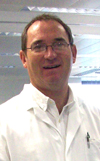|
|
|

|
Experience expands horizons for anatomy professor
|
by Cindy Abole
Public Relations
What happens when a human anatomy professor has a rare opportunity to
learn and train with colleagues in the oldest university in the
English-speaking world? He packs his bags and journeys more than 4,000
miles to study at Oxford University in Oxford, England.
 Dr. Thierry Bacro Dr. Thierry Bacro
MUSC associate professor Thierry Bacro, Ph.D., did just that for a week
in August as part of a collaborative human anatomy training and faculty
development program co-sponsored by the American Association of
Anatomists (AAA) and the Anatomy Society of Great Britain and Ireland
(ASGI). The AAA & ASGI’s Anatomy Training Program was established
to prepare basic science faculty with training in basic anatomy and to
hone teaching skills that can complement and enhance their biomedical
research knowledge and experience.
The program was organized in four specialty modules—head and neck,
limbs, neuroanatomy and trunk. Bacro, who teaches gross anatomy to
medical and dental students in MUSC’s Department of Regenerative
Medicine & Cell Biology, was selected as the joint program’s first
U.S. faculty participant to broaden his knowledge, skills and training.
He chose to study neuroanatomy.
“This was an extraordinary experience for me,” said Bacro, who has been
a faculty member with MUSC since 1995. “The way material was presented
and taught was very traditional, but slightly different from how we
teach in the U.S. Professor John Morris, especially, had a way to
present and discuss complex things in a very simple manner.”
The program’s premise was to establish international collaboration. It
also allowed institutions to respond to the growing challenge of
retiring senior faculty and the transfer of their knowledge to junior
faculty as they teach post-graduate students in the basic sciences such
as anatomy, neuroanatomy and physiology.
 Dr. Thierry Bacro
attended an anatomy training program with British colleagues at the
University of Oxford School of Medicine Anatomy Lab, Oxford, England.
for information on the program, visit http://www.anatomy.org/Education/training_program.htm. Dr. Thierry Bacro
attended an anatomy training program with British colleagues at the
University of Oxford School of Medicine Anatomy Lab, Oxford, England.
for information on the program, visit http://www.anatomy.org/Education/training_program.htm.
According to Bacro, programs like these promote more mentoring
experiences and other related programs.
The program hosted junior faculty and anatomists from areas around the
United Kingdom and Ireland. It required participants to work with a
faculty mentor at their home institution, attend anatomy lectures,
prepare lectures and teach and write reports.
For his Oxford experience, which was held Aug. 23-28, Bacro was joined
by mentor and former MUSC neurosciences colleague David Griesemer,
M.D., now chief of pediatric neurology at Tufts Medical Center. They
lived for a week in a residential school around Oxford and commuted to
the nearby University of Oxford School of Medicine anatomy lab.
Program participants were taught by Oxford University human anatomy
professor John F. Morris, associate head, Department of Physiology,
Anatomy and Genetics, and other Oxford colleagues. Participants
attended lectures, studied scientific specimens, reviewed materials and
participated in scientific discussions.
“Their labs had some of the most fantastic scientific specimens—both
fresh tissue and some frozen and cut,” Bacro said. “We learned a lot in
that short time. I found the program to be nicely organized with good
pedagogy and teaching skills, mentoring experiences and support
resources to prepare junior faculty.”
Bacro and Griesemer were required to prepare a paper for AAA about
their experience. Bacro now serves as a resource person and mentor to
the next class of the 2011 AAA & ASBGI Anatomy Training Program
(the group just selected three U.S. faculty to travel to Oxford next
August). He hopes to incorporate his experiences with students in the
dental and medical gross neuroanatomy classes.
Friday, Nov. 26, 2010
|
|
|




